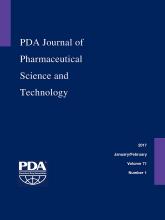Abstract
Contact plates, dipslides, and swabs are used for the microbiological monitoring of surfaces in controlled environments such as pharmaceutical clean rooms. In the present study, three different swab types using two different methods (direct streaking on agar versus elution followed by membrane filtration) were evaluated. In a first study, representative surfaces in pharmaceutical clean rooms were artificially inoculated using three different environmental strains (in vitro study). In a second study, a naturally inoculated floor was swabbed with the same three swab types, again using the two different recovery methods (in situ study). With the in vitro study, clear differences were found between the three swab types as well as between the two recovery methods. In addition, recovery rate of the swab type was dependent on the recovery method (interactive effect). One swab type showed a higher recovery rate with direct streaking on agar, while the other swab type showed better results using the elution/membrane filtration method. This difference can be explained by the fact that both swabs were each developed for their specific application. The type of surface also had a highly significant effect on the recovery rates. Recovery on stainless steel was better than for the other surfaces, while lexan had the lowest recovery rate. From the three different strains applied in the in vitro study, Micrococcus luteus had significantly higher recovery results compared to the other two strains (Bacillus thuringiensis, Aspergillus brasiliensis). The differences in recovery between the swab type and recovery method were less pronounced in the in situ study. In particular, the recovery of the swab type depending on the recovery method was not found. In conclusion, if swabs are to be used for environmental monitoring, their suitability should first be evaluated. This can be approached with artificially inoculated surfaces. However, naturally inoculated surfaces might be more realistic and might better reflect what is found in pharmaceutical clean rooms.
LAY ABSTRACT: Environmental microbiological monitoring provides information on the hygiene condition of pharmaceutical clean rooms and equipment for manufacturing of drug products. Different methods can be used to recover microorganisms. For surfaces, normally contact plates (e.g., RODAC or dipslides) are used; however, when surfaces are uneven, swabs should be used. In the present study three different swabs were evaluated for their ability to recover microorganisms from different surfaces. Thereby two methods and two approaches were evaluated. Swab samples were either directly stroked on agar or the swab was eluted, membrane-filtrated, and the filter placed on an agar plate. Experimentally, artificial inoculated surfaces typically found in clean rooms (in vitro study) and naturally inoculated floors (in situ study) were sampled. Thus with this approach the most convenient swab and the most suitable recovery methods under laboratory as well as real clean room conditions were evaluated. With this set-up, we found the most suitable swab for our environmental monitoring not only by using artificial inoculated surfaces but also under more realistic clean room conditions, which is most important for microbiological environmental monitoring sampling.
- Microbiological environmental monitoring
- Recovery rate
- Swab
- Membrane filtration
- Streak on agar
- In situ study
Footnotes
↵3 e-mail: alexandra.staerk{at}novartis.com
- © PDA, Inc. 2017
PDA members receive access to all articles published in the current year and previous volume year. Institutional subscribers received access to all content. Log in below to receive access to this article if you are either of these.
If you are neither or you are a PDA member trying to access an article outside of your membership license, then you must purchase access to this article (below). If you do not have a username or password for JPST, you will be required to create an account prior to purchasing.
Full issue PDFs are for PDA members only.
Note to pda.org users
The PDA and PDA bookstore websites (www.pda.org and www.pda.org/bookstore) are separate websites from the PDA JPST website. When you first join PDA, your initial UserID and Password are sent to HighWirePress to create your PDA JPST account. Subsequent UserrID and Password changes required at the PDA websites will not pass on to PDA JPST and vice versa. If you forget your PDA JPST UserID and/or Password, you can request help to retrieve UserID and reset Password below.






